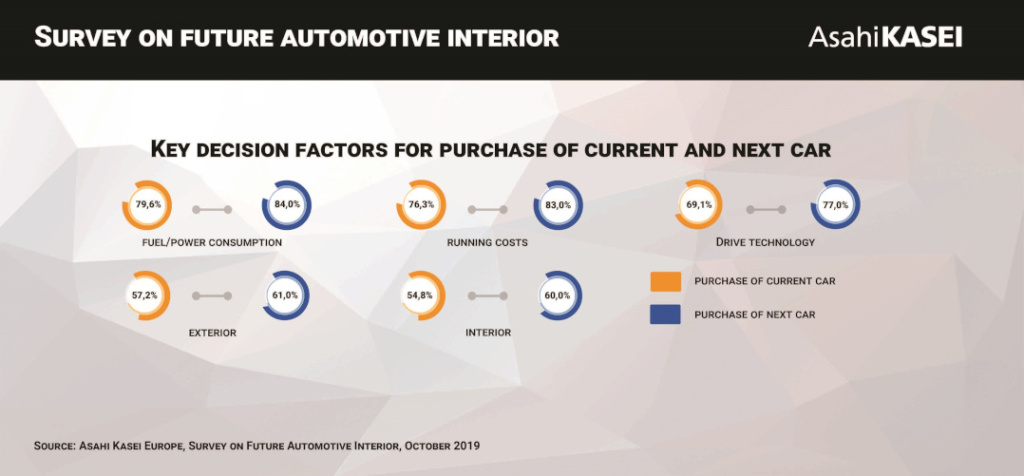The ongoing evolution in the automotive industry will change our driving experience. The focus of attention is shifting towards the interior design of cars – many interior concepts have been presented in the recent years. But what exactly does the customer expect?
“From 2025, AIEVs will gradually replace privately owned cars”. This quote by Dr. Akira Yoshino, Asahi Kasei Honorary Fellow and one of the inventors of the lithium-ion battery underlines the direction the automotive society is heading. “AIEV” – this abbreviation stands for “Artificial Intelligence Electric Vehicle” and is Dr. Yoshino’s vision of future mobility. By sharing fully autonomous, intelligent electric vehicles operating at the highest efficiency, the traffic as we know it today will change profoundly: Traffic accidents and privately-owned cars will decrease drastically, CO2 emissions will vanish. The cars will be moving energy storage systems, with fully automated charging cycles while discharging energy into the grid when not being used. The requirements for electric batteries will change – with the battery lifetime becoming an increasingly important factor. At the same time a high energy density for long-distance cruises with the EV will not be as important as it is today. “Range anxiety” – today one major obstacle for the popularity of electric vehicles – will become an issue of the past.
This picture painted here is more than just Dr. Yoshino’s vision – it is slowly coming to life. The ongoing CASE (Connected – Autonomous – Shared – Electric) megatrends are disrupting the automotive industry. Development cycles are accelerating, fuelled by tightening environmental regulations, but also by rapidly changing user’s demands. Because not only the vehicle itself, but also the driving experience is about to change. Due to the increasing autonomy of the car the users will have to focus less on the traffic – and will have more time to spend on work, in-car entertainment or just relaxation. As a result of this development, the focus of attention will shift to the automotive interior, rather than the exterior. But what is the car user expecting from the future automotive interior?

The Interior is to become the new exterior
In October 2019, Asahi Kasei Europe conducted a survey together with Cologne-based market research institute Skopos, interviewing a total of 1,200 car users in Germany, France, Italy and the United Kingdom regarding their preferences for the automotive interior of the future. When asked about the interior of shared cars, 73.5% of all respondents who already have used or who could imagine to use car sharing put a special emphasis on the cleanliness of the car, while 51.2% value premium surfaces, for example for seats or dashboards. Asked about cars in general, 73,4% of the respondents see antibacterial seats and surfaces as beneficial, with 60.7% being inclined to pay an extra price for those kinds of surfaces. A question about surfaces which look and feel particularly premium shows a similar result, with 73.5% of the respondents seeing a personal benefit in having premium surfaces in the car, and 61.8% being inclined to invest. 80.2% see benefit in an acoustic system which filters the vehicle’s background noise (63.8%), 78% in an acoustic system optimizing the input of voice commands (61.9%). In addition, 51.8% consider noise-absorbing seat covers and surfaces as a value-add inside the car (64.9%).
The voice of the customer is loud and clear: Needs and demands towards the future automotive interior are becoming increasingly complex and diversified. For the customer the interior will play a decisive role when choosing the next car. For the OEMs, this development means an increasing innovation pressure.
Heiko Rother, general manager, business development, Automotive at Asahi Kasei Europe, on the increasing importance of the automotive interior: “Customer expectations are not changing over night, but gradually and much faster than we have seen in the past. More than half of the car buyers in Europe are ready to change the brand. A great chance for OEMs to win new customers by implementing convincing technologies which are touching all senses, addressing human emotions and needs.”
As a highly diversified technology company covering a broad range of advanced materials and technologies from performance plastics and foams, stain- and odor repellent fibers for automotive interior, and electronic sound and sensing solutions, Asahi Kasei is offering solutions to these changing needs. By establishing its European Headquarter in Düsseldorf, Germany, in April 2016, the company is positioning itself as a partner for the European OEMs and Tier-1 suppliers to overcome the challenges Dr. Yoshino’s vision of future mobility is foreshadowing.
Sebastian Schmidt
Tel: +49 (0) 211-2806-8139
Mail: sebastian.schmidt@asahi-kasei.eu
CUT COTS OF THE FLEET WITH OUR AUDIT PROGRAM
The audit is a key tool to know the overall status and provide the analysis, the assessment, the advice, the suggestions and the actions to take in order to cut costs and increase the efficiency and efficacy of the fleet. We propose the following fleet management audit.




